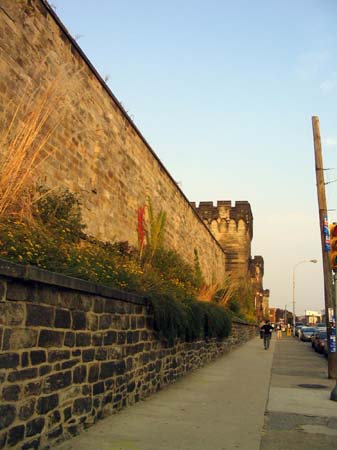One innovative use of the prison is a Halloween event called Terror Behind the Walls”, a scare fest filled with ghouls, gore and gallons of blood. It is easily the best haunted scare place my wife I have ever been to. Understand that we do not give such praise lightly. For my wife and I, Halloween is the bomb, it’s the shit, it is the best holiday of the whole year. I love decorating the house, I loved going to haunted scary places, I love Halloween parties. if we had to do it over again, we wouldn’t have gotten married 10/22 we would’ve waited till 10/31 and had a Halloween wedding. We even discuss redoing our vows and doing it on Halloween. But what’s the point? Spending that money for something we already did? Screw that, I’d rather put the cash towards a house. But I digress….
We both worked at a haunted greenhouse for several years and we had a ball. My wife was a guide and I played a variety of roles through the years, the best of which as eye-gore, the brother Igor, and I had my one eye covered with blood and gore and makeup, I was truly disgusting. One of my best shticks ever was when I tucked this small rubber rat, maybe 2 inches long but with a 4 inch tail, inside my cheek along with a small amount of fake blood. I would come out at the guests and babble away and eventually one of them would notice the tail sticking out of my mouth, and I would say “Where are my manners? You look hungry… I’ve already eaten but perhaps there’s something I could bring up for you,…” then I start making these horrible disgusting retching sounds. I’d slowly regurgitate the rat and offer it to the guests, often the blood would just flow from my mouth, sometimes drip down my chin, it was very disgusting I must say. I got THE BEST reactions from people, sometimes I’d chase them around offering them some dinner.
The place we used to work at is under new management and sadly it sucketh. I think a lot of haunted scare type places suck for a variety of reasons. Too much talking is usually the biggest reason. If you have q group you can scare and then intimidate and work off of, then the talking works, but if the crowd isn’t buying it, it’s like watching them die a slow death as they go thru their tired routines. I think most guests nowadays aren’t buying the doctor’s lab, the mad scientists kitchen or dining room, and even reanimating Frankenstein is old. And chasing them out the final room with Jason/Freddy/Leatherface is sooooo predictable. It’s been done to death. Talking rooms are just so predictable it’s boring.
The only way to really get people is with shocks and unexpected surprises. Innovative use of darkness, fog, noises, hidden panels, smoke, mirrors, robe lights and so forth. TBTW at ESP does this with more intensity then any place I’ve ever been. For a jaded scarefan like us to give this place enthusiastic thumbs up is saying something. (yeah I sound egotistical when I say that, but it really takes a lot to scare us or impress us and they did both). TBTW at ESP also has professional makeup jobs and incredibly good prosthetics and costumes. You can tell this isn’t done by teenagers in a trailer fighting over makeup supplies (ahhh the memories of scrounging to find a virgin piece of stipple…) The attention to detail shows, and really elevates it to the next level.
When you go to TBTW at ESP you should make reservations because otherwise the lines get long, however having a reservation at 7PM does not mean you go into the event at that time. There is a line outside, you then enter the walls of the prison, you give up your ticket, and then you have a choice. You can wait in the (potentially) long, or pay $5 more (per person mind you) and go to the front of the line. Unless the line is obscenely log, don’t take the fast pass. We had to wait 45 minutes or so but they run TV on an endless loop which features information about the prison, as well as clips from the MTV show fear which did an episode here. This, along with the prison spotlights and the actors running around scaring the crap out of the waiting customers.
I must say that one reason why I enjoyed myself so much has nothing to do with TBTW, it has to do with the company I kept. My wife’s girlfriends boyfriend Mimmo (rhymes with Nemo the fish) is such a scardey cat that we were pissing in our pants, alternately from being scared to laughing our asses off at him. There were times he was cowering behind the women, and other times we had to shove him down the corridor because he would not move forward. My wife had bruised wrists like Michael Jackson’s after he got arrested in Santa Barbara… At one point a ghoul started bothering him, then came to bother me, and I kept pointing back to Mimmo, and of course that made him nearly shit his pants. It’s always fun when you go with someone who is genuinely terrified.
What awaits you inside the walls? I won’t bother to describe what you’ll find inside as a) it should be obvious, b) I couldn’t possibly describe it that well it happens so fast, and c) why would I want to ruin it for you? I will say that they make extremely good use of fog, 3-D, hiding places, and sound… If you don’t believe me and my egotistic attitude, then ask Hauntfreaks.com who just rated it the best haunted attraction in the PA/NJ/DE area.
It turns out that the same guy who helped design Universal Studios Haunted attractions and Madison Scare Garden (both of which we’ve attended and thought highly of) was involved in the design of this place. From what I read, TPTW has been around for 6 years but initially wasn’t much more then a guide telling ghost stories. Not very chilling. With the recent redesign, they’ve established themselves as the place to go to get scared at Halloween.
MTV Filmed a segment of Fear here. Numerous documentaries about the prison have been filmed here as well as ones on ghosts. Here are hauntfreak.com’s final words on the subject: With proceeds going to such a worthy cause (the preservation of an amazing piece of architectural history), it is a bonus that we just can’t resist. Neither can we. Do yourself a favor. Make reservations, and get here during daylight to tour the prison, then go eat dinner and come back to get scared. It’s a day well spent.
Read about the history of the prison here
Read about the tour of Eastern State Prison here




